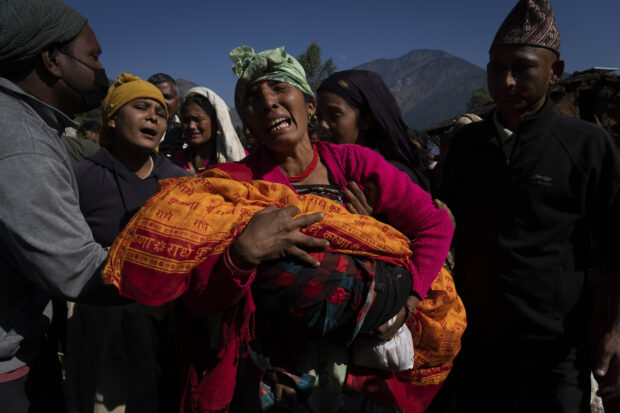Nepal villagers cremate loved ones who died in quake that killed 157
A woman holds the lifeless body of her grand child killed in earthquake in Jajarkot district, northwestern Nepal, on Sunday, November 5, 2023. Friday night’s earthquake in the district killed more than a hundred people while more than fifty were killed in the neighboring Rukum district, officials said. (AP Photo/Niranjan Shrestha)
KATHMANDU, Nepal — Villagers in the mountains of northwest Nepal on Sunday cremated the bodies of some of those who died in an earthquake two days earlier. The strong temblor killed 157 people and left thousands of others homeless.
The 13 bodies were carried to the banks of the Bheri River and placed on pyres made of stacked wood. Priests chanted Hindu prayers while family members cried as they covered the bodies of loved ones with flowers before setting them on fire in a cremation ceremony.
They were from Chiuri village in Jajarkot district, which authorities said was the epicenter of the quake and where at least 105 people were confirmed dead. Another 52 were killed in the neighboring Rukum district, officials said. There were 184 people injured.
READ: Death toll in Nepal earthquake reaches at least 157
Most of the houses in Jajarkot – usually made by stacking rocks and logs – collapsed or were severely damaged by the sudden earthquake, while the few concrete houses in towns were also damaged. The majority of those killed were crushed by debris.
Thousands spent Saturday night in the bitter cold.
People used whatever they could find to set up a shelter for the night, using plastic sheets and old clothes to keep them warm. Most people have been unable to retrieve their belongings from under the rubble.
Many were looking to the government for help.
“Our situation has gotten so worse that we do not even have anything left to eat. Whatever food we had is buried underneath the rubble of our fallen house,” Samkhana Bika, who had lost her home, said Sunday.
READ: Nepal earthquake kills at least 69
Her house at Chepare village had fallen. She sat around a fire near their fallen home to keep warm with her six family members.
“Someone else gave us some rice, a little oil, and some salt, out of which we made a stew last night and ate that,” she said.
Nepal’s government said it is trying to get aid to the affected areas.
A Cabinet meeting held Sunday, November 5, announced that aid would be immediately transported. Communications Minister Rekha Sharma told reporters that supplying food and setting up temporary shelters were the main focus while working on plans to reconstruct damaged houses.
As rescuers were scrambling to rush aid, operations were hampered because many of the mountainous villages could only be reached by foot. Landslides triggered by the earthquake also blocked roads. Soldiers could be seen trying to clear the blocked roads.
The US Geological Survey said that the earthquake had a preliminary magnitude of 5.6 and occurred at a depth of 11 miles (18 kilometers). Nepal’s National Earthquake Monitoring and Research Center confirmed that the epicenter was in Jajarkot, about 400 kilometers (250 miles) northeast of Kathmandu’s capital.
At the regional hospital in the city of Nepalgunj, more than 100 beds were made available, and teams of doctors stood by to help the injured.
“My arms are totally broken, I have injuries in my head and my back hurts, but thankfully it is not fractured. It was hurt when I had bent down and had firewood fall on my back,” Kunjan Pun said Sunday from a hospital bed where she is awaiting surgery.
Apart from rescue helicopters, small government and army planes able to set down in short mountain landing strips were also used to ferry the wounded to Nepalgunj.
The quake, which hit when many people were asleep in their homes, was also felt in India’s capital, New Delhi, more than 800 kilometers (500 miles) away.
Earthquakes are common in mountainous Nepal. A 7.8 magnitude earthquake in 2015 killed around 9,000 people and damaged about 1 million structures.















